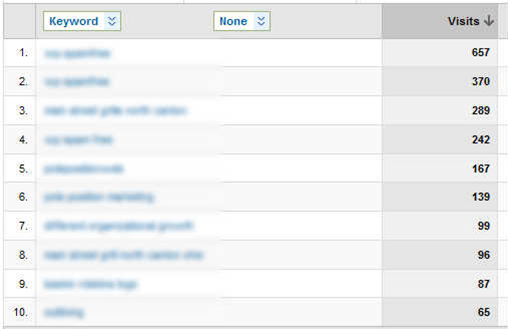Either reporting or looking at reports of your top X whatever rarely leads to insights. Why? They rarely change. Ok, once in a while they do, but for the most part, your top keywords, landing pages, referrers, etc. are going to be basically the same. This is because (for most, not all) what you’re offering doesn’t change. The problem is that when you look at a report like this…
…you are looking at static numbers. The key to getting insights from your website is looking at trends, or what’s changed. This opens up the doors to asking why things went a certain direction and finding out what’s really going on where.
To do this, you simply compare one time period of any metric that’s important to your business to its comparative time period. It could be this Sunday compared to last Sunday, this week compared to last week, this month compared to last month, this year compared to last year, or even last month this year compared to last month last year. It depends on the seasonality of your business and the amount of traffic you get. If you only get 1000 visitors per week, it’s not going to do much for you to compare weeks. It would be more beneficial to compare quarters or six month periods.

Now we have something to work with! Your top keyword fell by 17%? That’s worth looking into. You must be doing something right with #2 and #3. What? Over 20% drops with #5 and #7? What the heck happened?
Side Note: When you do a comparison for a shorter time period, make sure to compare data with days of the week aligned. For example, when looking at this month compared to last month, make sure your comparison lines up with the same days of the week to keep from having extra weekend or weekday days included that would skew the comparison. If you go back into the month before by a couple of days, that’s more important than getting the exact dates of the months right.
Look at Top Keywords
Remember that when you look at what’s changed for any dimension and metric to focus on changes that are significant. If a keyword falls by 30%, that could be concerning. Unless, of course, it went from 10 visitors to 7. You don’t care about that. If it went from 1000 to 700 or even 100 to 70, that would be worth looking into. Or if a keyword only fell 10%, but it was from 7000 to 6300, that would also be worth looking into. Therefore, it makes sense to look at only your top keywords over time periods that give enough volume to tell a significant story. So, you probably wouldn’t want to focus on #4 and #6 above.
Keyword Groups
Perhaps more importantly (if you’re using keywords for example), looking not only at single keywords, but groups or themes of keywords is important. If you’re targeting the keyword theme of “widgets,” you might not be quite as concerned if the exact term “widgets” had fallen as if the whole group of every keyword that contained “widgets” in it had risen when doing the same comparison. Therefore, look at the keyword group as a whole when doing your analysis to get a clearer picture of what’s going on.
Look at the Trend
Perhaps even more importantly, once you identify the keywords that have changed, you must look at the long-term trend of what’s happening, not just a comparison of two time periods. This tells a more accurate story. If a keyword or group of keywords decreased by 20% in the 2nd quarter compared to 1st quarter, it could be that there is a consistent downward trend or it could be that the keyword tanked in April, but rebounded back in May to even greater heights than pre-April. If this is the case, you might just focus in on that one month to see what might have happened so that you can keep it from happening again. Or, you might just keep your eye on this keyword and not worry much more about it at the current time. But, if it has decreased consistently month to month, it’s time to dig deeper and find out what the problem is.
There’s really no reason to spend time digging to find answers in areas where you don’t need to. Looking at the long-term trend and not just comparing two time periods helps you to make sure you don’t do that.
Conclusion
Focusing on what’s changed for a metric and important segments of traffic that matter while viewing it through the context of their trends over time is a great way to help you find areas to focus your analysis and attention, saving you time and improving results for your business.

